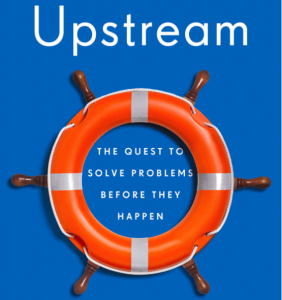
By Kelley Teahen, Vice President, Communications and Marketing, Parachute.
“Your victories are stories written in data, starring invisible heroes who save invisible victims.”
This line, from the first chapter of the just-released book Upstream: The quest to solve problems before they happen, made me gasp in recognition. The author, Dan Heath, is explaining why we have a difficult time embracing prevention, which in health-care and other circles is often referred to as “upstream intervention” – preventing a child from falling into the river, rather than rescuing the child as it drowns being carried downstream in the current.
I’ll quote his observation at length, preserving his U.S. spelling of “favor”:
“We tend to favor reaction because it’s more tangible: Downstream work is easier to see. Easier to measure. There is a maddening ambiguity about upstream efforts. One day, there’s a family that does not get into a car [crash] because a police officer’s presence made them incrementally more cautious. That family has no idea what didn’t happen and neither does the officer. How do you prove what did not happen? Your only hope is to keep such good evidence of crashes that you can detect success when the numbers start falling. But even if you feel confident your efforts accomplished something, you’ll still never know who you helped. You’ll just see some numbers decline on a page.”
And why did I gasp? Because my job is to tell the story of why prevention is important; of why prevention works; of why you should support efforts like our charity that prevent unintentional, serious injuries causing pain, suffering, and even death. We call these preventable deaths: the toddler who dies after ingesting a bottle of over-the-counter pain medication; the pedestrian hit and killed by an inattentive driver; the senior who slips on a throw carpet, falls, is hospitalized and never recovers.
When the toddler doesn’t swallow anything bad, the pedestrian crosses the street safely, and the senior’s home is set up to prevent falls, life carries on without a hiccup. Preventing bad things is invisible. The parent who stores medication properly and the designer and manufacturer who create child-resistant containers and locks are invisible. So, too, are attentive drivers, engineers who design roads to slow traffic and government officials who change building codes to make homes safer.
I’m a big believer in storytelling as the best way to share your message. But when it comes to injury prevention, the best story is no story.
And just how do you tell that?
Some people who promote injury prevention initiatives rely on stories from what I coin the “don’t do what I did, do what I say” genre. We hear from the quadriplegic person injured while diving who cautions against leaping into unknown waters, or the remorseful driver, drunk one night at the wheel, who crashed his car into another and killed a family of four.
Some parents take on the devastating task of sharing how their child died, and how that death could have been prevented if only proper prevention had been in place. I think of how heartbreaking it is to hear Ottawa resident Gord Stringer talk about his beloved daughter Rowan, who died in 2013 from a “second impact syndrome,” a swelling of the brain caused by a subsequent injury that occurs before a previous injury healed. Rowan likely experienced three concussions over six days while playing rugby: She had a concussion but didn’t know her brain needed time to heal, and neither did her parents, teachers or coaches. Gord, working with experts such as Parachute’s co-founder Dr. Charles Tator, has galvanized sports organizations and governments to adopt policies and rules to ensure athletes with suspected concussions are removed from play and get the treatment they need.
I wish Gord Stringer didn’t have this story to tell.
We can use those “numbers declin(ing) on a page,” to go back to Dan Heath, to tell powerful stories: the data can, and do, reveal transformative tales if they are visualized in an effective way. We can see encroaching and increasing dangers; we can see the effect of interventions from mandatory use of car seats to child-resistant pill bottles on injury and death.
Upstream is not a marketing book, although Heath along with his brother Chip did write Made to Stick, a 2007 bestseller that focuses on how to create memorable, “sticky” messages.
What are “sticky” messages when it comes to injury prevention? I’m making it my life’s work to find them, and share them. Thanks to Dan Heath for articulating the challenges of promoting “upstream” interventions so clearly.